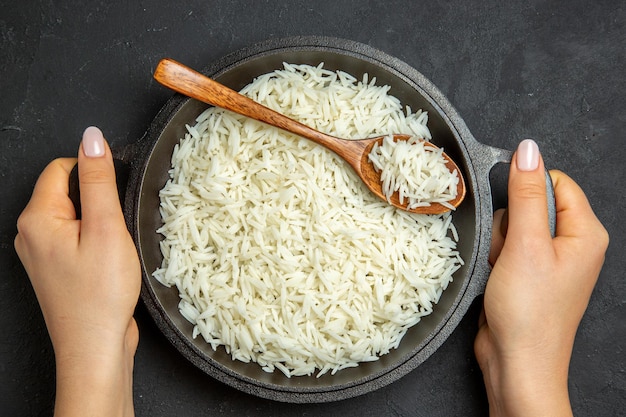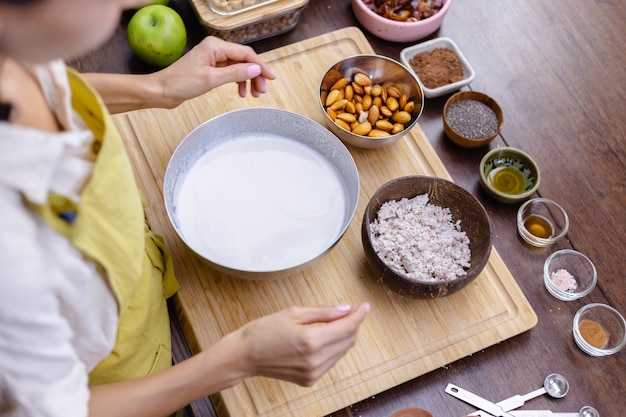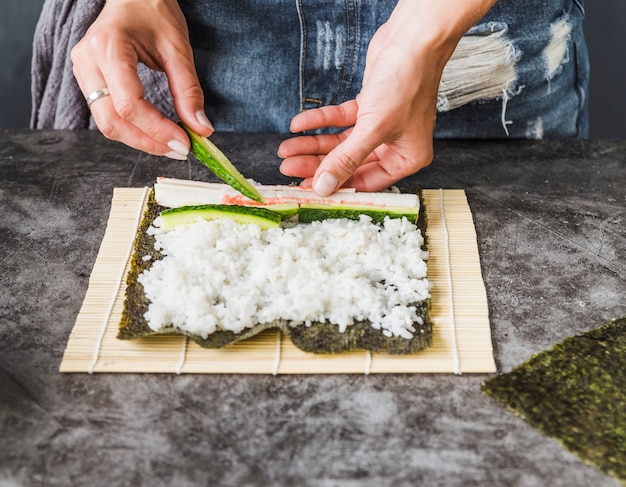Let's face it, rice is a kitchen staple for a reason. It's incredibly versatile, adaptable, and always seems to hit the spot. But, like many cooks, I've had my fair share of rice-related mishaps. I've been left with sticky, gooey messes, dry, crumbly piles, and everything in between. Over time, though, I've learned a thing or two about the art of making perfect long grain rice, and now I'm excited to share my secrets with you.
The key to achieving consistently perfect rice lies in a few essential elements – the right ratio of rice to water, the correct cooking method, and a dash of patience. It's not rocket science, but it does require a bit of attention to detail. So, grab your trusty saucepan or rice cooker, and let's dive into this culinary adventure together. You're in for a treat!
Part 1: The Foundation of Great Rice

Choosing Your Rice: More Than Just a Grain
Before we get our hands dirty, let's talk about the star of the show – rice! My personal favourite is long grain rice, particularly basmati. It has a lovely fluffy texture and a subtly nutty flavour, which makes it perfect for a range of dishes, from traditional curries to simple side dishes. But don't be afraid to experiment! You'll find many other varieties, like jasmine rice, known for its fragrant aroma, and brown rice, which offers a hearty and nutty flavour.
When selecting your rice, I always opt for brands I trust and make sure it's stored properly at home. Airtight containers in cool, dry places are your best bet. This helps to prevent moisture absorption and spoilage, ensuring your rice stays fresh and flavourful.
The Art of Washing: Removing Excess Starch
Now, this is a step that many people overlook, but it's crucial for achieving perfect rice. Washing your rice removes excess starch, which can lead to a sticky, gummy texture. I used to skip this step, but once I embraced it, I was amazed by the difference!
The process is simple. Just place your rice in a fine-mesh strainer and rinse it under cold water until the water runs clear. You'll be surprised by the amount of cloudy water that washes away – that's the excess starch being removed!
The Perfect Ratio: Rice and Water in Harmony
This is where the science comes in, but don't worry, it's not complicated. For long grain rice, the ideal ratio is usually 1:1.5, meaning for every cup of rice, you'll use 1.5 cups of water. However, this ratio can vary slightly depending on the type of rice and your preferred texture. If you like your rice extra fluffy, you might use a slightly lower water ratio.
Remember, experimentation is key! Don't be afraid to adjust the ratio slightly until you find what works best for you.
Part 2: The Stovetop Method: A Classic Approach

Getting Ready: Setting the Stage
Alright, we've chosen our rice, washed it, and figured out our perfect ratio. Now it's time to get cooking! I personally prefer the stovetop method because it allows for greater control over the cooking process. You can use a saucepan or a rice cooker, but the basic principles remain the same.
First, grab a pot and fill it with water. Bring the water to a rolling boil. Patience is key here – you want to see those bubbles dancing vigorously. For enhanced flavour, I always add a pinch of salt to the boiling water.
Adding the Rice: The First Steps
Once the water is boiling, gently add your washed rice to the pot. Stir it gently to ensure all the grains are submerged. Now, bring the water back to a boil, cover the pot with a lid, and reduce the heat to a low simmer. This is where the magic truly begins!
Allow the rice to simmer for about 15-20 minutes, or until the water is absorbed and the rice becomes tender. Resist the temptation to lift the lid during this time. It's essential to allow the steam to do its work and cook the rice evenly.
The fluff test: A Test of Doneness
After 15-20 minutes, cautiously lift the lid and take a peek. If the water has been absorbed, and the rice looks fluffy and tender, you're ready to go! But if the rice seems slightly hard or there's still water left, cover the pot again and let it simmer for a few more minutes.
I always perform a "fluff test" to ensure perfect doneness. Gently take a grain of rice between your fingers and press it. If it easily breaks apart, it's ready! If it's still a bit hard, give it a couple more minutes of simmering.
Part 3: The Rice Cooker Method: Effortless Convenience

The Effortless Way: A Hands-Off Approach
For those who prefer a more relaxed cooking experience, a rice cooker is a fantastic option. It takes the guesswork out of rice preparation, making it incredibly convenient. Simply measure your rice and water according to the rice cooker's instructions, add a pinch of salt, and press the 'cook' button. Let the rice cooker do its thing while you focus on other tasks.
Different Settings: Customization at Your Fingertips
Most rice cookers have different settings like 'white rice,' 'brown rice,' 'quick cook,' and even 'sushi rice.' Don't be afraid to experiment with these settings to find what works best for your preferences. You can customize the cooking process to achieve the perfect texture for your chosen dish.
Many rice cookers also have a 'keep warm' function. This is a lifesaver for keeping your rice warm and fluffy for extended periods, perfect for large gatherings or if you're planning to eat later.
Part 4: The Finishing Touches: Elevating Your Rice
Resting Your Rice: Allowing It to Breathe
Once your rice is cooked, whether on the stovetop or in a rice cooker, it's essential to let it rest for about 10 minutes. This allows the rice to steam properly and absorb any remaining moisture, resulting in a fluffier, more consistent texture.
Fluffing Your Rice: Separating the Grains
After resting, use a fork, wooden spoon, or even chopsticks to gently fluff the rice. This helps to separate the grains, preventing them from sticking together. It also creates a light and airy texture, adding to the overall appeal of your rice.
Seasoning Your Rice: A Personal Touch
Now, this is where personal preference takes over. Some people enjoy the pure, simple flavour of plain rice, while others like to add a touch of flavour. A drizzle of olive oil or a sprinkle of sesame seeds can instantly elevate the dish.
You can also experiment with other seasonings like soy sauce, mirin, a touch of ginger, or even a squeeze of lime juice. Let your creativity run wild!
Part 5: Serving Your Rice: Presenting Perfection
Your rice is ready! It's time to enjoy the fruits of your culinary labour. Here are a few serving tips to enhance your rice experience:
- Serve your rice immediately after cooking for optimal flavour and texture. The aroma will be at its peak, and the grains will be wonderfully fluffy.
- If you're not eating it right away, keep it warm in a covered dish or in your rice cooker's 'keep warm' function. This helps to maintain the delicious texture and prevent the rice from drying out.
- Don't be afraid to get creative with your serving bowls. Try using beautiful ceramic bowls, bamboo baskets, or even rustic wooden bowls for a charming touch.
Part 6: Recipes with Rice: Expanding Your Culinary Horizons
Rice is a blank canvas for culinary creativity! It's a delicious and healthy base for a wide variety of dishes. Here are a few of my favourite rice recipes to inspire you:
Chicken fried rice: A Classic comfort food
This is a classic for a reason. It's simple, satisfying, and incredibly versatile, using whatever leftover chicken and vegetables you have on hand. I like to use a combination of chicken, carrots, peas, onions, and eggs. But feel free to add your favourite vegetables and even a dash of your preferred spices.
rice salad with Mango and Coconut: A Refreshing Delight
This is a light and refreshing salad that's perfect for warmer weather. I like to use a combination of rice, mango, coconut flakes, red onion, and a tangy lime dressing. The mix of textures and flavours is a true treat!
Shrimp Curry with Rice: A Flavourful Journey
This is a comforting and aromatic dish that will tantalize your taste buds. I use a combination of shrimp, coconut milk, curry powder, and vegetables like potatoes, carrots, and onions. The creamy coconut milk adds a richness to the dish, while the curry powder provides a warm and spicy kick.
Part 7: Rice Storage: Keeping Your Rice Fresh
Once you've cooked your rice, it's best to store any leftovers in an airtight container in the refrigerator. It will keep for up to 3 days. However, keep in mind that the texture and flavour of rice can change slightly after being refrigerated.
If you plan to use your leftover rice for a dish like fried rice, it's best to reheat it in a pan with a little bit of oil or water. This helps to prevent the rice from becoming dry and crumbly, ensuring a delicious outcome for your dish.
Part 8: Tips for Perfect Rice Every Time: A Few Final Notes
Here are a few more tips and tricks to ensure you get perfect rice every time:
- Invest in a good quality rice cooker if you frequently cook rice. It's a real game-changer, taking the guesswork out of the process.
- Avoid overcooking your rice. It can turn mushy and lose its appealing texture. Keep a close eye on the cooking time and don't hesitate to check for doneness a little earlier than recommended.
- Experiment with different types of rice. You'll discover your personal favourites, from the subtle flavour of basmati to the fragrant aroma of jasmine rice.
- Don't be afraid to get creative with your rice dishes. There's no right or wrong way to enjoy it! Try different flavour combinations, add a variety of vegetables, or even incorporate it into your favourite salads and soups.
Part 9: FAQs: Your Rice-Related Questions Answered
1. What if my rice is too sticky?
If your rice is too sticky, it probably means you didn't wash it properly. Try rinsing your rice for a longer period of time, or use a slightly lower water ratio next time.
2. What if my rice is too dry?
If your rice is too dry, you may have used too little water or cooked it for too long. Try using a slightly higher water ratio or reducing the cooking time by a couple of minutes.
3. Can I use brown rice instead of white rice?
Absolutely! Brown rice is a healthier option than white rice, but it does take longer to cook. Check the packaging for the recommended cooking time. It's also best to use a little more water than you would for white rice.
4. What should I do if my rice is undercooked?
If your rice is undercooked, simply add a little more water to the pot, cover it, and let it simmer for a few more minutes.
5. Can I cook rice in the microwave?
You can, but it's not the ideal way to cook rice. The results can be inconsistent, and the rice can often end up dry or unevenly cooked. For the best results, stick to the stovetop or rice cooker method.
Now, go forth and conquer your rice-making adventures! Remember, with a little practice and these tips, you'll be serving perfect rice every time.
Everyone is watching

Prime Rib Roast Cooking Time Chart: Per Pound Guide
Cooking TipsPrime rib roast. Just the name conjures images of lavish dinners, crackling fires, and hearty laughter. It’s ...

How Long to Bake Potatoes in the Oven (Perfect Every Time)
Cooking TipsBaked potatoes are a staple in my kitchen. They're incredibly versatile, delicious, and surprisingly easy to m...

Perfect Rice Every Time: The Ultimate Guide to Cooking Rice
Cooking TipsAs a self-proclaimed foodie, I've always been a bit obsessed with rice. It's the foundation of countless cuisi...

The Ultimate Guide to Cooking Asparagus: Tips, Techniques, and Recipes
Cooking TipsAsparagus. The mere mention of this spring delicacy conjures up images of vibrant green spears, crisp and burs...

Ultimate Guide to Cooking the Perfect Thanksgiving Turkey
Cooking TipsThanksgiving. Just the word conjures up images of overflowing tables laden with delicious food, the scent of r...
